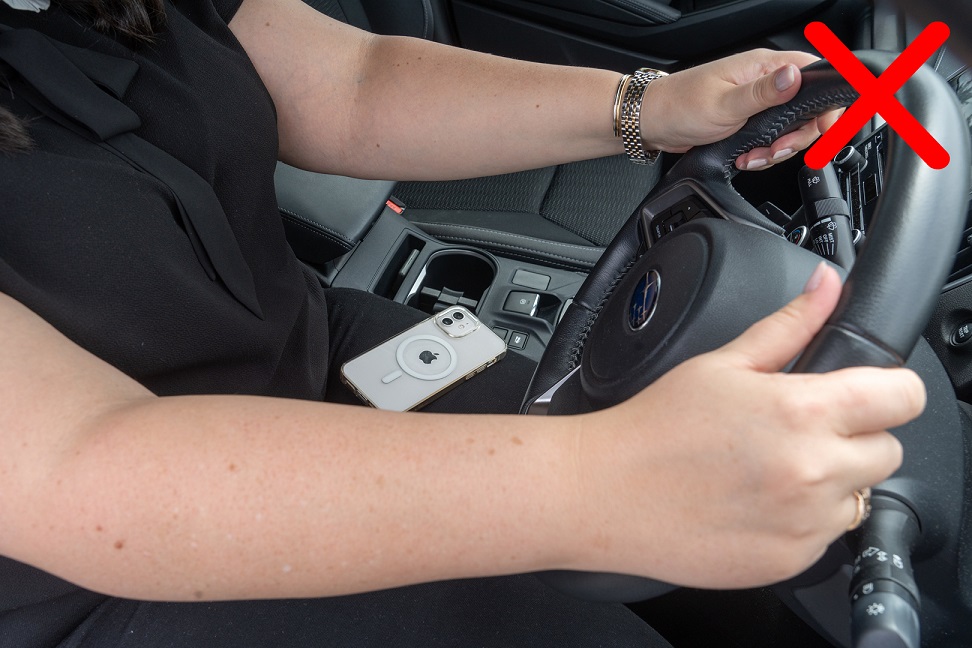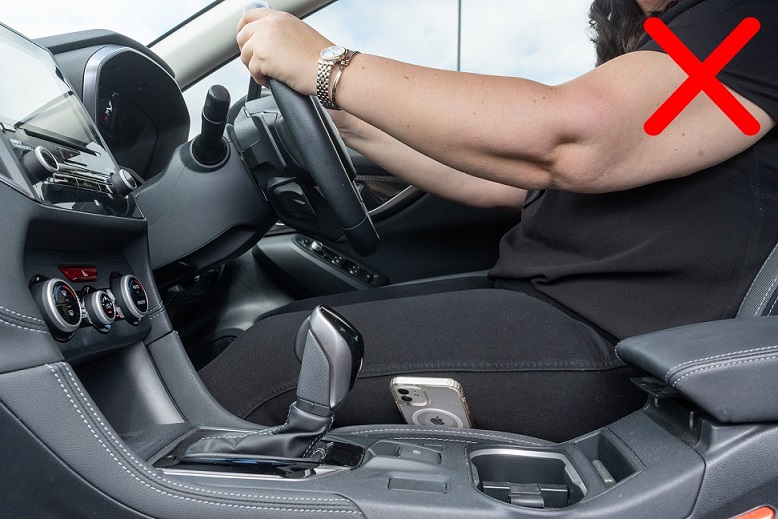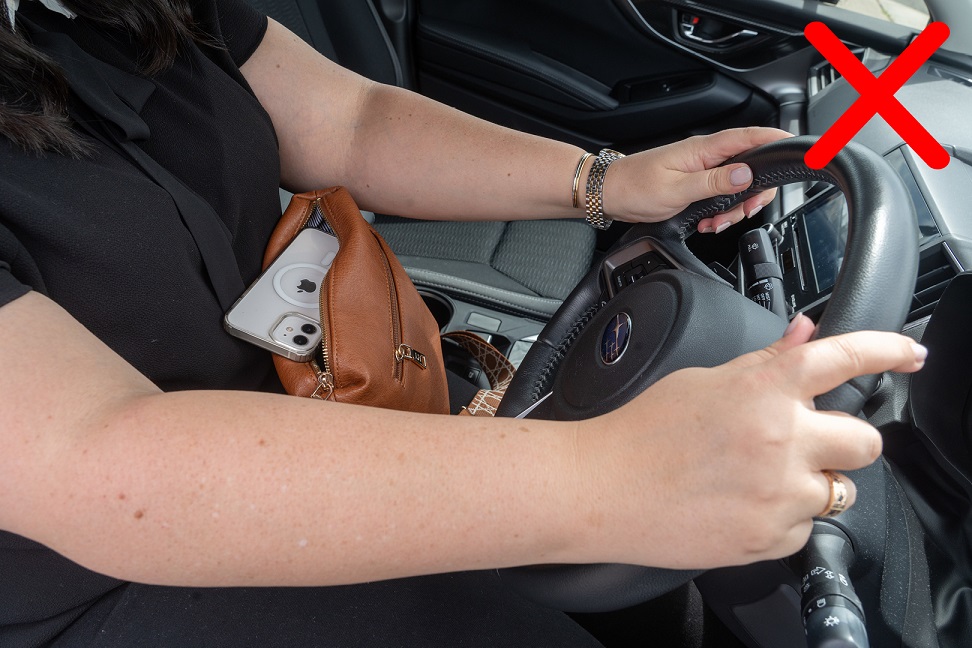Mobile device distraction
Mobile phones and devices are a source of distraction while driving and increase your risk of a crash. Taking your eyes off the road for more than 2 seconds doubles the risk of a crash.
You cannot use a mobile device illegally while driving. Penalties apply for illegal use of mobile devices. Mobile device detection cameras are used in the ACT. ACT Policing also issue infringements to drivers found illegally using mobile devices.
Mobile devices include mobile phones, smartwatches, tablets and any other wireless handheld or wearable device that can be used for telecommunications. They do not include a CB radio or any other two-way radio.
Some exemptions are in place and different rules apply for full licence holders, provisional drivers and learner drivers. See below for more details.
Rules for all drivers
- While a vehicle is moving (or stationary but not in park) you cannot use a mobile device. This includes stopping at traffic lights.
- If you are driving you cannot:
- hold a mobile device
- rest the device, or keep it in place, on your body, clothing or on an item on your lap or under your leg, or
- operate any function of the device (such as video calling, texting, emailing, social media, web browsing or photography).
- You should put your phone away before you drive. You can keep your phone in a pocket or pouch as long as you do not operate it.
- You can wear ‘wearable’ devices such as a smartwatch if you do not use or operate them. You could be fined if you use or operate a wearable device.
Exemptions for full licence holders
Full licence holders are allowed to use mobile devices in the following instances:
GPS navigation
GPS navigation
You can use your mobile device as a navigation tool (for example using a maps app), provided:
- your mobile device is mounted to the vehicle using a mobile phone holder or connected via Bluetooth or wired connection (such as CarPlay or Android Auto), and
- you do not touch your mobile device or change the settings in any way while you are driving.
Music or audio
Music or audio
You can use your mobile device to play audio while driving, but:
- you cannot hold your mobile device (including having it resting on any part of your body or on an item on your lap), and
- you cannot touch your mobile device or change the settings in any way while you are driving.
Audio calls
Audio calls
You can use your mobile device to make or receive audio calls. The following conditions apply:
- If your mobile device is mounted to the vehicle using a mobile phone holder or connected via Bluetooth or wired connection (such as CarPlay or Android Auto), you can touch your device while it is in a mobile phone holder (or use your steering wheel controls or touch the CarPlay or Android Auto screen) to make or receive calls but for no other reason.
- If your device is not mounted to the vehicle or connected via Bluetooth/wired connection, you can still answer or make a call if you do not touch your mobile device, rest the device on your body, clothing or on an item on your lap, or change the settings in any way. For example, you can accept the call using voice activation.
Rules for learner and provisional drivers
A full mobile device ban is in place for learner and provisional drivers. This includes phone calls using handheld or wearable devices such as headphones or speakers.
This means it is illegal to text or use social media, Bluetooth, hands-free or speaker mode while you are driving. Even touching your mobile device or the CarPlay/Android Auto screen is an offence. This includes to skip a song or use voice to text.
Listening to music or audio
Listening to music or audio
As a learner or provisional driver you can listen to audio while driving, provided:
- you do not hold the device or rest it on your body or on an item on your lap
- you do not interact with the device while driving, including by voice or through the CarPlay/Android Auto screen.
You should set up and play your music playlist before you drive as you cannot skip or change songs on your mobile device while driving. This includes using CarPlay or Android Auto.
GPS navigation
GPS navigation
As a learner or provisional driver you can use your mobile device for GPS if your device is mounted to the vehicle or connected via Bluetooth/wired connection and does not require interaction by any means while driving. This includes by voice or through the CarPlay/Android Auto screen.
You should set up your GPS instructions before you drive as you cannot make changes while driving. If you need to change your GPS settings or instructions during the journey, pull over and park at a safe place first.
Taxi, rideshare and hire car drivers
The use of a mobile device as a dispatch system is permitted under the rules as a driver’s aid. This means that rideshare, taxi and hire car drivers can touch their phone to accept or reject a job request through a dispatch system provided the mobile device is secured in a mounting affixed to the vehicle.
Penalties
Penalties apply for the illegal use of mobile devices. ACT Policing actively targets people illegally using their mobile phones while driving. Mobile device detection cameras are also in operation in the ACT.
Fines include:
- Using a device for messaging, social networking, accessing apps or the internet: $674 and 4 demerit points.
- Using or holding a device for any other reason (unless an exemption applies): $548 and 3 demerit points.
For a full list of penalties please see the Road Transport (Offences) Regulation.
Mobile device detection cameras
Mobile phone detection cameras detect and photograph people using a mobile device illegally while driving. If a camera detects you using a mobile device illegally while driving, you will receive an infringement notice.
Cameras operate at all times. Images detecting a potential offence are cropped to only show a view of the driver. They are reviewed and verified before an infringement notice is issued. A robust range of security and privacy safeguards are in place governing the use and disclosure of the images.
What cameras detect
What cameras detect
Cameras detect the following:
- a driver of a vehicle holding a mobile device in their hand at the ear or above the shoulder
- a driver of a vehicle holding a mobile device by resting the device between the ear and the driver's shoulder
- a driver holding a mobile device in their hand or hands, including where it is held at chest level or below
- a driver touching, but not holding, a mobile device with their hand where the device is not secured in a mounting affixed to the vehicle
- a mobile device that is resting on any part of the body of a driver whether or not the device is also touched or held by a hand (except where the device is in a pocket of the driver's clothing or in a pouch that is worn by the driver).
Locations
Locations
Cameras are usually installed at locations where there is:
- a history of crashes
- previous detection of illegal mobile device
- increased risk due to vulnerable road users.
Fixed cameras are located on Hindmarsh Drive and on Gungahlin Drive. Three transportable cameras rotate across a number of locations across Canberra.
To see the full list of mobile device detection camera locations, visit the ACT Government Open Data Portal.
Privacy
Privacy
Security and privacy safeguards are in place governing the use and disclosure of images captured by mobile device detection cameras.
Two privacy impact assessments were undertaken before the cameras came into operation. For more information see a summary of both assessments, recommendations and actions (PDF 437.8 KB).
A copy of both assessments can be requested through the FOI online request form. The documents will not be provided in full.
Tips for drivers
Using a mobile phone while driving is just as dangerous as drink driving. Follow these tips to stay safe while driving.
- Put your phone away. If you do not need your mobile device for navigation or audio purposes, leave it in your bag or in the glovebox.
- Set yourself up before you drive. Set your GPS and playlists up before you leave. Make sure you won’t need to change any settings while you are on the road. If you need to make any changes, find an appropriate place to pull over.
- Pull over if you need to. If you really need to make a call or send a message, pull over and park safely first.
- Turn on the 'do not disturb' function. To make sure you aren’t tempted by incoming notifications while you are driving, before you start to drive switch your smartphone to ‘do not disturb’ if it has this function.





